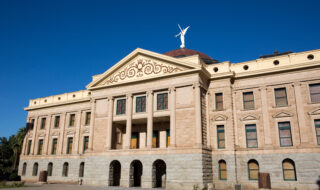October 29, 2025
The Paid Family and Medical Leave (PFML) mandate is scheduled to go into effect in Minnesota on January 1, 2026
In 2023, in spite of NFIB’s objections, the Minnesota Legislature passed legislation that imposed a government-run Paid Family and Medical Leave (PFML) mandate on small business owners and their employees. Despite ongoing efforts to make common sense modifications to the PFML mandate, the program is currently scheduled to go into effect on January 1, 2026.
Previous posts have looked at the fundamental basics of the mandate and steps that small employers should take to prepare. This post will break down the small employer tax rate, the narrowly tailored seasonal hospitality employee designation, and the employment protections associated with the PFML mandate. This information, and more, can also be found by accessing the Minnesota Department of Employment and Economic Development’s (DEED) Employer Resource Toolkit.
Small Employer Tax Rate
The Minnesota PFML mandate applies to virtually all employers – regardless of size. However, certain small employers may be eligible for a reduced Small Employer Payroll Tax rate if (1) they employ 30 or fewer people and (2) the average wage for that employer is less than or equal to 150% of the state’s average wage in covered employment.
- 30 or Fewer Employees – An employer must employ 30 or fewer people to be eligible for the Small Employer Tax Rate. The employee count that is used to determine “small employer” status is “the largest number of Minnesota employees reported by an employer on a single wage detail report during the four–quarter period that ended September 30 of the prior year.”
- Average Employee Wage is ≤150% of the State’s Average Wage– To qualify for the Small Employer Tax Rate, an employer must also have an average employee wage of 150% or less of the statewide average for their base period (about $107,000 in 2025).
For 2026, the Small Employer Payroll Tax rate is 0.66% (as compared to the 0.88% rate for all other employers). Of this amount, the small employer must pay one-third of the total payroll tax (0.22% of covered wages) and may shift the remaining two-thirds (0.44%) of the payroll tax to their employees.
Small employers will not need to formally apply for the Small Employer Payroll Tax rate – the State will automatically calculate the average number of employees and average weekly wage for each employer. If an employer meets the criteria for a small business, the reduced tax rate will be applied. As a reminder, Minnesota Paid Leave has a payroll tax calculator that can be used to estimate program costs employers and employees.
Seasonal Hospitality Employment Designation
The PFML mandate is extremely broad and applies to virtually every employer – regardless of industry or size. This means that, as a general rule, most seasonal and hospitality employees will be covered by the PFML mandate. However, seasonal hospitality employers can request a special designation to receive a narrow exemption for certain seasonal hospitality employment.
An employer who seeks to designate seasonal hospitality employment will need to submit a request to Minnesota Paid Leave and meet the following three criteria:
- The employer must be an employer in the hospitality industry
In the context of this designation, employers in the “hospitality” industry include: boarding establishments, food and beverage service establishments, food carts, hotels or motels, limited food establishments, lodging establishment, mobile food units, resorts, restaurants, seasonal permanent food stands, school concession stands, seasonal temporary food stands, and special event food stands.
If your business is not within one of these industries your request for a seasonal hospitality employment designation will be denied by Minnesota Paid Leave.
- The employer must qualify as seasonal.
To qualify as a “seasonal employer” for this designation, the employer must submit receipts from the prior calendar year that show that they bring in most of their revenue during six months of the year. An employer will be deemed to bring in most of their revenue during six months of the year if the gross receipts from the six highest months of sales are three times greater than the receipts from the six lowers months. Note that the months do need to be consecutive. Employers seeking this designation will need to submit receipts each year to prove that they still qualify as seasonal.
- The designated seasonal hospitality employees must be employed no more than 150 days in a 52-week period.
A designated seasonal hospitality employee is one who is “employed for no more than 150 days during any consecutive 52-week period in hospitality.” Again, “hospitality” includes boarding establishments, food and beverage service establishments, food carts, hotels or motels, limited food establishments, lodging establishment, mobile food units, resorts, restaurants, seasonal permanent food stands, school concession stands, seasonal temporary food stands, and special event food stands.
Employer Obligations Required After Approval
If an employer’s request for a Seasonal Hospitality Employment Designation is approved, Minnesota Paid Leave will send the employer instructions on how to report their wage detail accordingly. Employers will also receive instructions on how to submit a quarterly seasonal hospitality employee list. This list must be submitted each quarter, otherwise the Seasonal Hospitality Employment Designation may be revoked by Minnesota Paid Leave. This list will also need to be updated each time the employer hires someone who is to be designated as a seasonal hospitality employee.
Employers must also provide written notices to employees who are designated for seasonal hospitality employment. The notice must inform the seasonal employee that they are not eligible to receive paid family and medical leave benefits while the employee is so employed. The notice must be provided by December 1, 2025 (if they are already employed) or when they are offered the job. Delivery is made when an employee provides written or electronic acknowledgement of receipt of the information or signs a statement indicating that the employee’s refusal to sign such acknowledgement. Failure to properly notify employees can result in penalties and loss of designation.
Employers who received the Seasonal Hospitality Employment Designation are required to notify Paid Leave within 5 business days of (1) no longer meeting the definition of a seasonal hospitality employer or (2) an employee who is designated as a seasonal hospitality employee will be employed for one than 150 days in a consecutive 52-week period.
Final Note: If a designation is granted, it applies to individual employment – not to the entire business. When seasonal employment is designated, employees working in designated employment cannot take PFML and payroll taxes are not owed on their wages.
More information on the Seasonal Hospitality Designation can be found here, as well as on Minnesota Paid Leave’s Seasonal Hospitality Employment guide. Detailed instructions on how to submit a Seasonal Hospitality Designation Request can be found here.
PFML Employment Protections
In addition to the various components of compliance with the PFML mandate, small employers should also be aware of the numerous employee protections that are associated with the mandate. Employment protections are enforced by the Minnesota Department of Labor and Industry’s (DLI) Labor Standards Division.
Some of the primary employment protections that will be enforced by DLI include:
- Right to Reinstatement: Employees are generally entitled to be reinstated to the same position that they held when leave commenced or to an equivalent position with equivalent benefits, pay, and other terms and conditions of employment. in their job after their leave ends if they have been in the position for at least 90 days.
- Anti-Retaliation: Employers are prohibited from discharging, disciplining, penalizing, interfering with, threatening, restraining, coercing, or otherwise retaliating or discriminating against employees for requesting or obtaining benefits or leave, or for exercising any other right under the PFML laws.
- Anti-Interference: Employers are prohibited from obstructing or impeding an application for leave or benefits or the exercise of any other right under the PFML laws.
- Maintain Insurance Policies: Employers are required to maintain coverage under any group insurance policy, group subscriber contractor, or health care plan for the employee and any dependents while on Paid Leave. The employee must continue to pay any employee share of the cost of such benefits.
More information on the required employment protections under Minnesota Paid Leave can be found at DLI’s website.
Additional Resources
The Paid Leave Division at DEED has hosted several webinars that are aimed at informing employers about their responsibilities under the PFML mandate. A list of upcoming events and recordings from previous webinars can be found here.
Small business owners can also visit DEED’s Minnesota Paid Leave website for a FAQ and other additional resources.
How Will PFML Impact Your Business?
The Minnesota PFML mandate is the single-biggest employer mandate that has ever passed in Minnesota. There is no question that it will have a heavy administrative and financial impact on small businesses, as well as an impact on their ability to effectively manage their workforce. As you are working towards complying with the PFML mandate, please fill out this member survey to let us know about the impact that this mandate will have on your business, as well as any issues that you encounter with compliance.
NFIB is a member-driven organization advocating on behalf of small and independent businesses nationwide.
Related Articles














